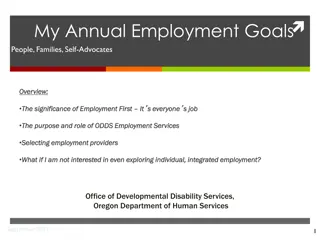Understanding Employment Impact Measurement in Energy Projects
Reflections on measuring the employment impacts of energy projects at the partner country level, exploring tools, methods, gaps, and challenges. Discusses the integrated GIZ approach to employment promotion, ILO's decent work concept, quantifying employment effects, and possible indirect effects. Emphasizes the importance of considering various levels of employment effects and different types of job creation.
Download Presentation

Please find below an Image/Link to download the presentation.
The content on the website is provided AS IS for your information and personal use only. It may not be sold, licensed, or shared on other websites without obtaining consent from the author. Download presentation by click this link. If you encounter any issues during the download, it is possible that the publisher has removed the file from their server.
E N D
Presentation Transcript
SOME REFLECTIONS ON HOW TO MEASURE EMPLOYMENT IMPACTS OF ENERGY PROJECTS AT PARTNER COUNTRY LEVEL: TOOLS & METHODS, GAPS & CHALLENGES Dr. Steffen Erdle, Head of Project RE-ACTIVATE: Promoting Employment through RE/EE in MENA 5thTeam Retreat & Planning Workshop Cairo, 7.-9.2.2017 Page 1
Integrated GIZ Approach to Employment Promotion 18/09/2024 Page 2 RE-ACTIVATE Planning Workshop Cairo
Not just promoting more but also better work ILO s decent work concept: Guaranteeing rights at work Extending social protection Promoting social dialogue ILO s core labour standards: Freedom of association and right to collective bargaining Elimination of forced or compulsory labor, incl. child labor Elimination of discrimination at the workplace 18/09/2024 Page 3 RE-ACTIVATE Planning Workshop Cairo
Quantifying Employment Effects Direct jobs: for people working in a specific sector Indirect jobs: for people working up- & downstream for suppliers and distributors Induced jobs: resulting from increased income and consumption of direct and indirect workers Net job creation: also accounting for job losses in competitors 18/09/2024 Page 4 RE-ACTIVATE Planning Workshop Cairo
Several Types of Possible Indirect Effects Displacement effects: jobs created by a program come at the expense of jobs outside the program ( crowding out ) Substitution effects : jobs created for a certain category of workers replace jobs for other categories due to changes of relative wage costs Deadweight effects : the program subsidizes hiring that would also have occurred in the absence of the program Mind the opportunity costs! jobs created by the program could also be created somewhere else with less input 18/09/2024 Page 5 RE-ACTIVATE Planning Workshop Cairo
Possible Employment Effects at Different Levels Direct employment effects: fostering employment e.g. at the level of the service providers and in newly founded start-ups Direct and indirect employment effects: fostering e.g. an increase in competitiveness through the promotion of innovation/value chains Indirect employment effects: fostering employment e.g. through interventions at the level of framework: conditions => greatest potential for broad impact, but the causality is difficult to prove! 18/09/2024 Page 6 RE-ACTIVATE Planning Workshop Cairo
Measuring Employment Effects RE sector impact studies Beyond the RE industry, but not economy- wide impact studies Economy-wide impact studies Covered effects Direct Employment factor approach Direct Supply chain analysis Direct, indirect Input-output modeling Direct, indirect Employment factor approach with scenario comparison (RE and CE industry) Direct, indirect, induced IO modelling including an adjustment of the consumption vector (electricity prices) Direct, indirect, induced Full economic model with scenario comparison 18/09/2024 Page 7 RE-ACTIVATE Planning Workshop Cairo
Employment Factor Approach EF provide a direct link between physical or financial units (capacity installed, actual production, money invested ) and employment Simple multiplication only leads to approximate estimates Transfer of EFs from one region to another require knowledge and data about the respective production and service structures The literature knows a wide range of EF, because: Indirect effects are included or excluded Different system boundaries and different scales are mixed, e.g. EF for roof-top systems differ from large ground-mounted ones 18/09/2024 Page 8 RE-ACTIVATE Planning Workshop Cairo
Input-Output Models Economic tool for the analysis of direct and indirect effects Illustrates the effects of additional demands in one industry on all industries in the economy IO tables are available for more than 100 countries in the world Consistent analytical framework helping to connect an analysis of RE deployment to an analysis done for other sectors or the whole economy Problem: IO tables only valid when carefully constructed and consistently updated 18/09/2024 Page 9 RE-ACTIVATE Planning Workshop Cairo
Full Economic Models Models differ by economic theory and philosophy Computable General Equilibrium (few data) Macro-econometric (full system of national accounts and balances, time-series) Other simulation models (agent based, system dynamics) (full SNAB) All include feedback reactions, distribution effects and adjustments of the economy Problem: high requirements with regard to quality data 18/09/2024 Page 10 RE-ACTIVATE Planning Workshop Cairo
Special Challenges for the Energy Sector (RE/EE) Employment effects vary strongly and are difficult to measure: - Capital-intensive markets, long lead times, heavy political impact - Rapidly evolving worldwide markets, high degree of context specificity - Extreme technological & industrial dynamics - Strong variations between countries and technologies - Effects distributed over time and along the supply chain - Effects differing in terms of the duration and the location - High requirements in terms of the availability and quality of data 18/09/2024 Page 11 RE-ACTIVATE Planning Workshop Cairo
Comparison of Employment Factors: M&I vs. O&M 18/09/2024 Page 12 RE-ACTIVATE Planning Workshop Cairo























